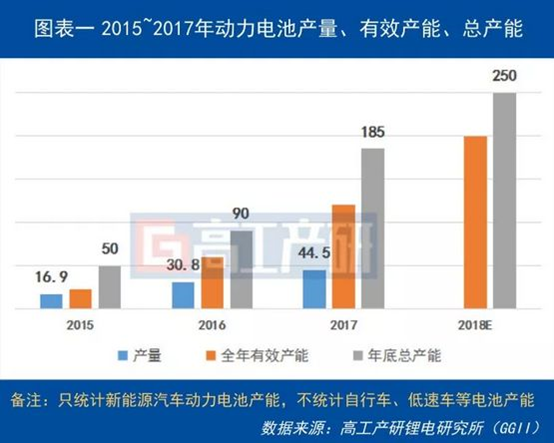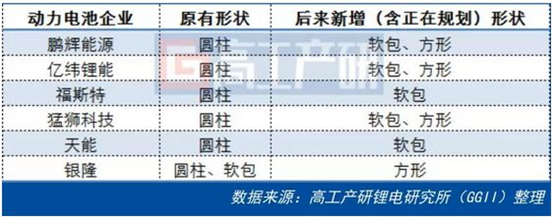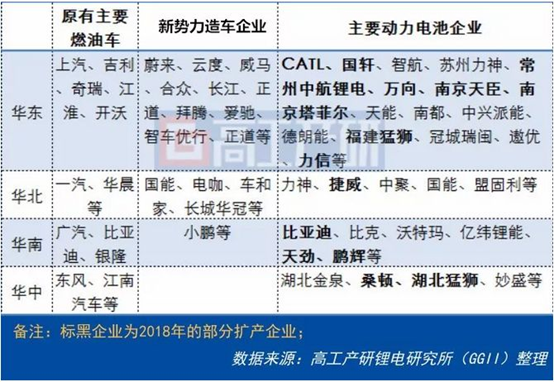As of April 2018, the total capacity of China's power batteries was 200GWh, an increase of 110GWh compared to the end of 2016, and 2016-2017 is an upsurge of domestic power battery construction. In 2015, the new energy automobile industry emerged a surge of rushes, and once there was a shortage of power battery capacity. In 2015, the subsidies for new energy vehicles were high and raw material costs had not risen sharply. As a result, the profitability of power batteries in 2015 was high, gross profit margins generally exceeded 30%, and many new entrances were attracted by high gross profit and huge market development space. The Group (group companies, listed companies, and original digital lithium battery companies) began to build capacity for power batteries. The power battery companies that have already been established have also accelerated their production capacity. According to the GGII data, over 30 domestic power battery companies were established between 2015 and 2017. Their capacity planning is generally 6~10GWh, and the construction is divided into three phases. Currently, the first phase of construction is basically completed. In 2017, the country’s power battery shipments were 44.5GWh, the output was over 50GWh, and the capacity utilization rate was less than 40%. The domestic power batteries had a structural surplus. In 2018, there was a big change in the domestic power battery industry. First, subsidies for new energy vehicles continued to decline, which drove the price of power batteries to decline. The current power electric system price is 1.2~1.4 yuan/Wh, which is nearly 30% lower than that at the beginning of 2017, and the price of other ternary materials has risen sharply by 4~60,000/ton from the beginning of 2017, driving the high cost of power battery and driving the power battery by double factors. The gross profit declined, and the industry as a whole remained at 20%~25%. Second, the differentiation among enterprises was intensified. The gap between first-tier and second-tier echelon enterprises and third- and fourth-tier companies is seen from the perspective of shipments. The trends of the elder Hengda are obvious, that is, it is more difficult for third and fourth-tier enterprises to obtain orders. Thirdly, the subsidy threshold has been raised, the terminal’s demand for power batteries has increased, and the lack of R&D capabilities and the product quality that cannot be continuously improved has not been applied. As a whole, in 2018, the power battery segment showed: falling profitability, centralized orders, continued improvement in performance, accelerated differentiation, and different types of raw material price fluctuations. In the overall low capacity utilization rate of power battery in the country, GGII research and analysis believes that in 2018, the enthusiasm of capacity expansion in the power battery industry is not high as a whole. The new scale will be lower than 2016-2017, and the new year is expected to add 60~65GWh. Total capacity, effective capacity is expected to increase by 70 to 80 GWh, and the number of new effective capacity is greater than the total capacity, because part of the capacity in 2017 is gradually released, that is, it takes a certain buffer time to reach the design capacity. The expansion of power battery in 2018 will have the following characteristics: The main body of the expansion is clear, and scale enterprises and new entrants are the main force for expansion As of April 2018, China's power battery companies approached 120 (including construction), more than 70% of the company's annual production capacity exceeded 1GWh, less than 5% of the company's production capacity exceeded 8GWh, and more than 20% of the company's production capacity was between 2~8GWh. Is an intermediate company. In 2018, it was limited to financial pressures and uncertain orders. The expansion of intermediate echelon companies has been tightened as a whole, and they need to focus more on funds and enterprise efforts on product R&D and customer development. Of course, the middle echelon still has some enterprises with small total production capacity and good momentum of development, which will continue to expand production, such as Tianjin shares and Penghui. In 2018, there are mainly three forces that are the main expansion forces. One is a company that has achieved certain market share and has a certain scale. It needs continuous expansion to meet the needs of customers in 2020 and beyond. Such representative companies include CATL, Fu-Neng, BYD, and Guoxuan; The second type of enterprise is a battery company that was established in 2016~2017. It needs to build the first phase of production capacity, such as Ruipu Energy, Tafir, and Huading Guolian. The third category of enterprises is the need for multi-technology development and the construction of another type of battery production capacity, such as Hubei Mengshi, Jiangsu Far East Foster, and Lixin. The investment of the first type of companies in the three types of enterprises is even larger. The single-phase new capacity is 4~10GWh. Newly added square and soft bag production capacity In 2015-2016, a number of new entrants in China took the column 18650 as a cut-in entrance, and significantly increased their production capacity. The 18650 has been commercialized for more than 30 years. Driven by Japanese and South Korean companies, it has achieved a high degree of automation, a relatively low barriers to entry, and a faster construction cycle, making it the first choice for new entrants in 2015~2016. With the launch of the fully automatic 18650 production line introduced from South Korea, the domestic production capacity of 18650 power batteries has exceeded 12 million, which is far greater than the demand, so the expansion will be tightened. Cylindrical power batteries have a high degree of automation, high single-cell energy density, and low cost, but their packs are complex, their cycle life is short, and their fast charge performance is poor. Therefore, they are mainly used in mini-vehicles and logistics vehicles. The loading capacity of the above models is still very small. In the short term, domestic car companies are more inclined to square or soft pack batteries, so in 2017 some cylindrical battery companies began to lay out other shapes of power batteries. Construction capacity is mainly distributed in East China and North China As the core component of the car, power battery is the core of building a factory around the car. In South China, 3C electronics and digital home appliances are developed, but the auto industry is less developed than Eastern China and other regions. From the point of view of the production capacity of the new forces manufacturers, they are also concentrated in the East China region. Therefore, expansion of power batteries is still mainly in East China and North China. From the point of view of the expansion of power batteries in 2018, the expansion of power batteries is more targeted, reflecting both the technical line and product positioning; the overall expansion of the power battery industry has become cautious; the expansion of production is more regional, It is further built around the depot. Nuts Peeling Machine,Peanut Peeling Machine,Dry Way Peanut Peeling Machine,Dry Type Peanut Peeling Machine Yantai Maoyuan Food Machinery Manufacturing Co.,Ltd , https://www.peanutmachinery.com


